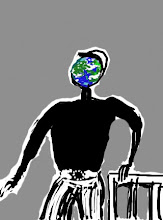Amongst many other arguments, Timothy Morton's hectic but stimulating
Ecology without nature: rethinking environmental aesthetics (Harvard University Press 2007) situates Tolkien both in terms of the longer tradition of ‘Romantic nationalism’ and environmental art.
As the idea of world (Welt) became popular in German Romantic idealism, so the nation-state was imagined as a surrounding environment. The idea of the nation as “homeland” … demanded a poetic rendering as an ambient realm of swaying corn, shining seas, or stately forests. Nature appeared sublime “there” and yet fundamentally beyond representation, stretching beyond the horizon and back into the distant, even pre-human past. It was a suitable objective correlative for the je ne sais quoi of nationalist fantasy. Walter Scott’s invention of historical novels, realist fictions generating an entire world in a bubble of past-tense narrative, did as much for environmental nationalism as explicitly Romantic criticisms of modern society and technology. [97]
He goes on to read Tolkien in this light.
The Shire, in J R R Tolkien’s The Lord of the Rings depicts the world bubble as an organic village. Tolkien narrates the victory of the suburbanite, the “little person,” embedded in a tamed yet natural-seeming environment. Nestled into the horizon as they are in their burrows, the wider world of global politics is blissfully unavailable to them. Tolkien’s work embodies a key nationalist fantasy, a sense of “world” as real, tangible yet indeterminate, evoking a metonymic chain of images—an anamorphic form. The Lord of the Rings establishes not only entire languages, histories, and mythologies, but also a surrounding world. If ever there was evidence of the persistence of Romanticism, this is it.
In Heidegger’s supremely environmental philosophy, the surrounding ambience created by Tolkien’s narratives is called Unwelt. This is the deep ontological sense in which things are “around”—they may come in handy, but whether they do or not, we have a care for them. It is a thoroughly environmental idea. Things are oriented in relation to other things: “the house has its sunny side and its shady side.” Others (elves, dwarves, men) care for their surroundings differently. The strangeness of Middle-earth, its permeation with others and their worlds, is summed up in the metaphor of the road, which becomes an emblem for narratives. The road comes right up to you front door. To step across it is to cross a threshold between inside and outside. There is a sense that the story, and the world it describes, could go “ever on and on” like the road in Bilbo Baggins’s song. But wherever we go in this world, however strange or threatening our journey, it will always be familiar, insofar as it has all been planned in advance, mapped out , accounted for. This planning is not quite as narrowly rational as a modern factory. Still, the recent film of The Lord of the Rings, with its built-in commentaries on the special edition DVD about the craftsmanship and industrial processes that went into making it, reveals something true about the book. The Umwelt is a function of holistic, total design, total creation: Wagnerian Gesamtkunstwerk with a how-to booklet thrown in. The holistic world that ‘”goes ever on and on” is exciting and involved, but in the end, it is just a gigantic version of the ready-made commodity. This is ironic, since one of the themes of the work is the resistance to industrialism and specifically to commodity fetishism, in the form of the hypnotic ring itself. [98]
This is interesting stuff, although Morton evidently feels rather condescendingly about the book itself: ‘what gets lost in this elaborate attempt to craft a piece of kitsch that could assuage the ravages of industrialism?’ he asks, answering ‘hesitation, irony, ambiguity’, glossing the middle term via Schlegel. I can see the ‘kitsch’ part, although it doesn’t strike me as a necessarily bad thing (on the contrary). But something is missing from this analysis; precisely the unexpected thing (the unexpected party) that Morton claims the novel erases. Since this is particularly true of the book’s engagement with ‘environmental aesthetics’, it’s a shame Morton doesn’t discuss it. Take: Tom Bombadil. It’s true he was smoothed over and erased by the more commodified film version of the tale; but he’s a crucial figure in the
Fellowship (in some senses
the crucial figure). He does not represent, but literally embodies, the irreducibility of ‘nature’ as something other than the ‘human’ world. Of course, he embodies this through a metaphysical logic of incarnation that as crucial to (Catholic) Tolkien’s world-view; and it’s possible that Morton has little sympathy with incarnation from an OOO-point of view—I don’t know, but I can imagine that the way the Christian concept prioritises ‘the human form’ over all over objects, to the point where the universe itself, or God, or (in LotR) Nature somehow metaphysically ‘is’ the human form … I can believe that such views are immiscible with OOO. Nonetheless one the things that is so wonderful about Tom Bombadil is precisely the way he doesn’t fit the well-tooled story model, the ‘road’ that the film-makers trod. It is precisely his gnarly peculiarity, his oddity, his naffness (blue coat, yellow boots! Endless fol-de-rol singing!). His non-identity. He represents precision a sort of narrative hesitation -- that's why Jackson and his screenwriters ditched him for their film version.

No comments:
Post a Comment